Sawadee! Thailand recommends itself to you by its unique heritage, rich culture, tasty food, sunny beaches, and most of all the kindness and generosity of the Thai people. Let's get a glimpse of eight must-have experiences in Thailand that would definitely interest you.
1. Visit the temple ruins of Wat Mahathat, Ayutthaya
The Wat Mahathat, built in 1374 (during the Sukhothai dynasty), is one of the earliest Khmer pagodas in Ayutthaya, which houses 198 stupas. As a UNESCO World Heritage Site, the Wat Mahathat was once the religious center of Ayutthaya.
The famous Buddha head in the tree is a must-see here. The head of the Buddha is wrapped in the roots of a Bodhi tree, just as it grows out of the tree. Viewed from the side, it looks like the Buddha is smiling. You will feel the peace and mystery of the Buddha at first sight.
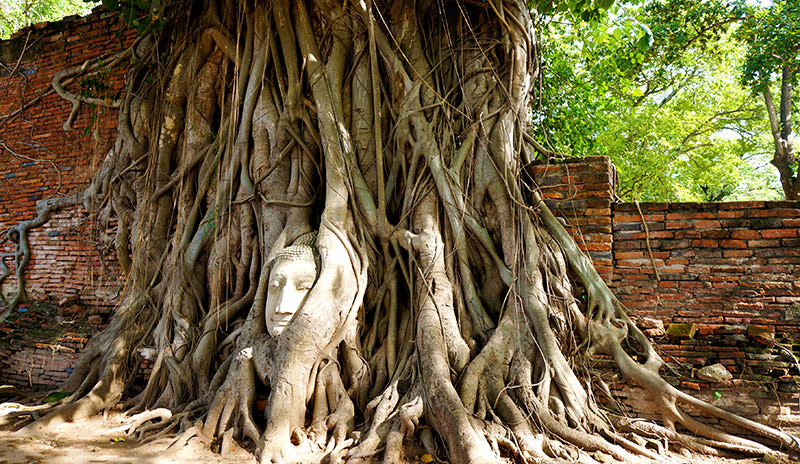 The Buddha head in the roots of the Bodhi tree.
The Buddha head in the roots of the Bodhi tree.
The sacred Wat Mahathat is an indispensable part of Thai history. There are many other iconic ruins, including headless Buddha statue in situ, remains of the Royal Vihara, mural painting in situ, false windows of the Royal Vihara and Chedi in situ, etc. All the fragmentary relics will tell you how glorious this royal temple ever was and take you on a journey to explore the history of Thailand.
Location: Naresuan Rd, Tambon Tha Wa Su Kri, Amphoe Phra Nakhon Si Ayutthaya, Chang Wat Phra Nakhon Si Ayutthaya 13000, Thailand
Opening hours: 8:30 AM to 5:00 PM, Monday to Sunday
Entrance fee: 50 baht only for the Wat Mahathat, 220 baht for admission of all attractions in the Ayutthaya Historical Park
Notes: Usually, near the Buddha head in the tree, there is a guard on duty to keep the tourists follow the rule.
2. Tour the Grand Palace complex, Bangkok
Established in 1782 by King Rama I, the Grand Palace was the royal palace of the kingdom of Siam from the 18th to the 20th Century. Nowadays, it remains the spiritual heart of the Thai Kingdom and it is used for ceremonies such as the king's coronation and court celebration. Wander in this spectacular palace complex, you will see not only the royal halls and the throne, but also the renowned Temple of the Emerald Buddha (Wat Phra Kaew).
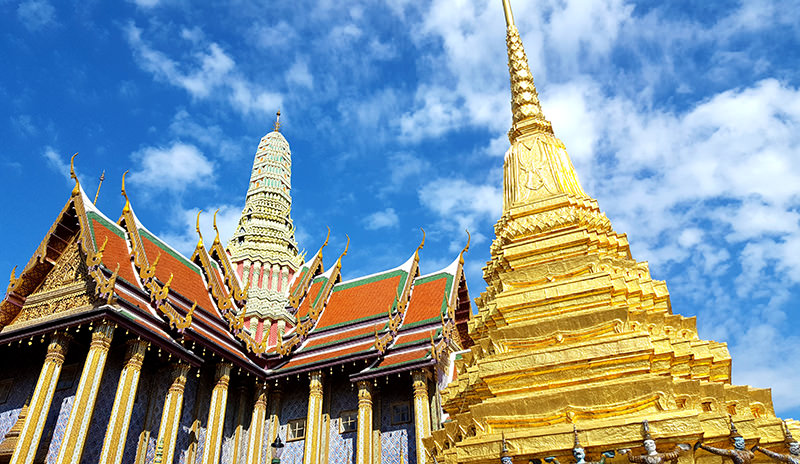 The Grand Palace.
The Grand Palace.
Wat Phra Kaew is considered as one of the most important Buddhist temples in Thailand and enshrines the Emerald Buddha which was meticulously carved from a single block of jade. Dedicated on a high gold throne, the Emerald Buddha is in the meditating position and it is greatly revered by Thai people. The replacement of the robes on the Buddha is changed with the three seasons in Thailand (respectively hot season, cool season and rainy season), which is personally done by the King of Thailand. It is an important ritual on the Buddhist calendar with a wish of protecting the peace and security of Thailand.
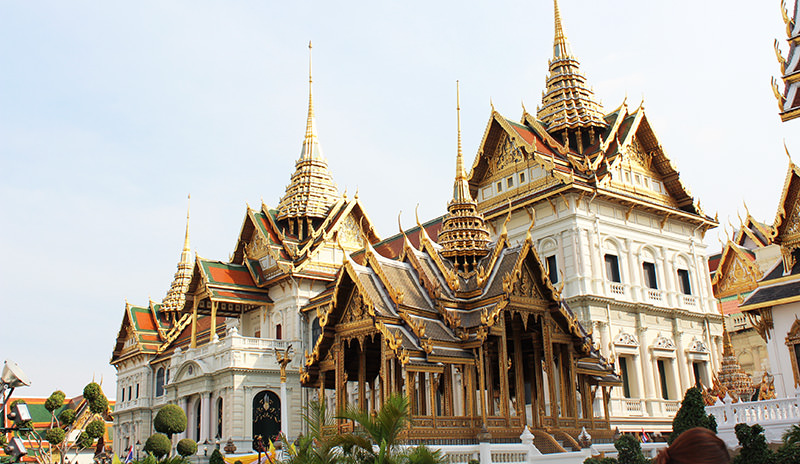 Temple of the Emerald Buddha.
Temple of the Emerald Buddha.
Every year, thousands of visitors tour the Grand Palace and are in awe with its beautiful architecture, brilliant Buddha, elaborate decorations and intricate details. At the top of many must-see lists in Thailand, the Grand Palace won't let you down!
 The brilliant architecture in the Grand Palace.
The brilliant architecture in the Grand Palace.
Location: Na Phra Lan Rd, Khwaeng Phra Borom Maha Ratchawang, Khet Phra Nakhon, Krung Thep Maha Nakhon 10200, Thailand
Opening hours: 8:30 AM to 3:30 PM, Monday to Sunday
Entrance fee: 500 baht
Notes:
1. Strict dress code for visiting palaces or temples. Men must wear long pants and shirts with sleeve no tank tops. If you're wearing sandals or fig-flops you must wear socks. (No bare feet). Similarly, women must be modestly dressed, no see-through clothes, bare shoulders, no ripped jeans, etc. So trousers and long sleeves tops are recommended.
2. Take off shoes before you go into temples.
3. It is forbidden to take photos in the Wat Phra Kaew.
4. It is usually boiling hot in the Grand Palace, so you'd better bring an umbrella and sunglasses. Don't forget to take plenty of water.
3. Appreciate cultural performances at Siam Niramit Theatre, Bangkok
Siam Niramit Theatre is not only a theatre but also an interactive theme museum inheriting the history and cultural traditions of Thailand. In the continuous 80-minute performances, there are three Acts respectively Journey back to History, Journey Beyond Imagination, and Journey through Joyous Festivals. Appreciating classic shows at Siam Niramit Theatre is just like a journey to the enchanted Kingdom of Siam. You will observe the characteristics of Thai civilization in different periods of development.
The Three Acts
The first Act Journey back to History: expressing a theme that for over seven centuries, Siam has been home of diverse cultures, a cross-road where civilizations meet via four representative historical stories respectively about the ancient Kingdom of Lanna in northern Thailand, traders from overseas to barter goods in the south seas of Thailand, heritage of the Khmer civilization in the northeast (Issan), and the mighty capital Ayutthaya in the central Plains.
The second Act Journey beyond Imagination: presenting the three imaginary worlds namely Fiery Hell where the condemned souls receive punishment that matches the nature and gravity of their crimes, Mystical Himappan which is home to various mythical creatures between the human world and the heaven, and Blissful Heaven where Indra presides and angels perform an elegant aerial dance.
The third Act Journey through Joyous festivals: revealing a Thai Buddhist belief that one must gather merit on earth to go to heaven. There are numerous merit-making festivals combining religious ceremonies with colorful and joyful celebrations in Thai culture, such as Ordination Ceremonies, Songkran, the Phitakhon Ghost Parade, and Loy Krathong, etc.
Location: 19 Thiam Ruam Mit Rd, Khwaeng Huai Khwang, Khet Huai Khwang, Krung Thep Maha Nakhon 10310, Thailand
Opening hours: 4:30 PM to 10:00 PM, Monday to Sunday. The showtime starts at 8:00 PM. The dinner time is from 5:00 PM to 7:50 PM.
Tickets: Two kinds of tickets: 1,500 baht for the show only standard seat and 2,000 baht for the show only golden seat, no matter you are an adult or a child. If you want dinner (buffet), you will need to pay an extra 350 baht per adult and 210 baht per child.
Notes:
1. Usually, there are less than 100 VIP seats in the 2,000 seats. During the performances, the staff may select some VIP guests to interact and give away gifts.
2. It is forbidden to take photos in the theatre.
4. Celebrate Songkran Festival with Thai people
Songkran Festival is to celebrate the Thai New Year, which is from April 13th to April 15th. In Thai culture, they believe water is pure and clean, which can be used to take bad luck away. You will have a deep insight into Thai culture and the life attitude of Thai people by celebrating the Songkran festival with locals.
How Songkran Festival is celebrated
Early in the morning, people start on the journey of gratitude. Thai people go to temples to worship the Buddha. They piously use clean water to clean the Buddha and move the sand into the temples to build sand stupas, using colorful flags and flowers to decorate. Thai people also worship and sprinkle water to the Buddha images and floats of the goddess Songkran in disguise which paraded on city streets. You will see crowds of people roam around, using water pistols and soaking anyone in the vicinity to express greeting and blessing.
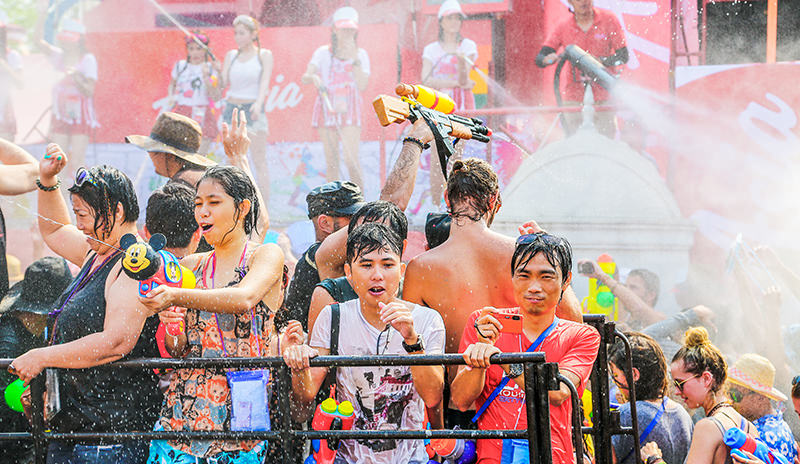 People celebrating the Songkran Festival
People celebrating the Songkran Festival
Everyone avoids saying any unfortunate or hurtful things during the Songkran festival. They will visit elders and receive their blessings. Also, Thai people will do some benefaction, such as freeing captive animals, offering things to the monks. Doing some cleaning and taking a bath are also important aspects of the Songkran festival.
Notes: If you are ready to experience this carnival of water, don't forget to wear some dark-colored clothes to protect privacy.
5. Taste typical snacks and fruits at a floating market, Bangkok
The floating market is not merely a shopping place, but also a characterful scenic spot. Start a floating market tour via a long-tail speedboat ride, and you will see some traces of the bygone way of life. Salt farms and lush country come into view. You will meet with many impressive workshops and the breathtaking orchids. Additionally, floating markets are great for taking some memorable pictures.
Treat yourself with typical street foods, snacks, and fresh fruit drinks. Find your heart's desire in a dazzling array of handicrafts, souvenirs, clothing & accessories products, essential oil, and spice. Apart from Thai exotic cheap-and-fine goods, you will get a unique taste of traditional Thai life at the floating market.
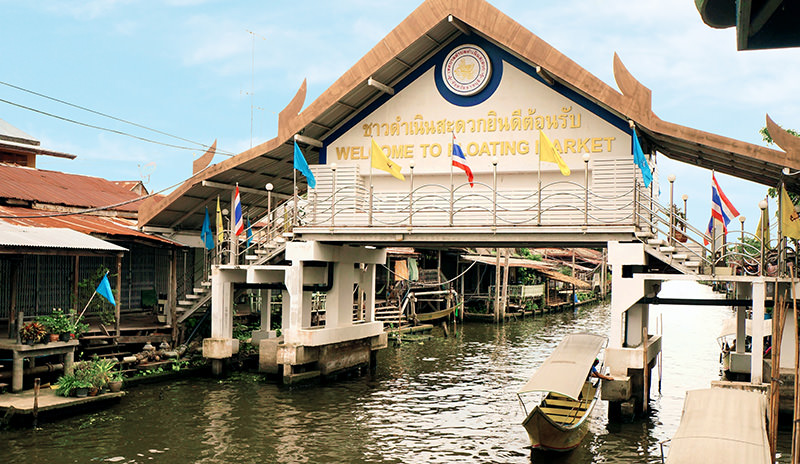 The floating market in Thailand.
The floating market in Thailand.
Recommended floating markets
Damnoen Saduak Floating Market: this century-old traditional floating market (100 km or more than an hour's drive outside Bangkok) is full of boats that are loaded with fruits, flowers, vegetables, and various goods. It is huger, livelier and more colorful than other floating markets. The best time to visit is early morning. You can capture the perfect photo of what a floating market is like. The prominent disadvantages of this market are touristy, a far distance from Bangkok, most of the tourist-oriented transactions and serious overpricing. So, be prepared to haggle for the best price.
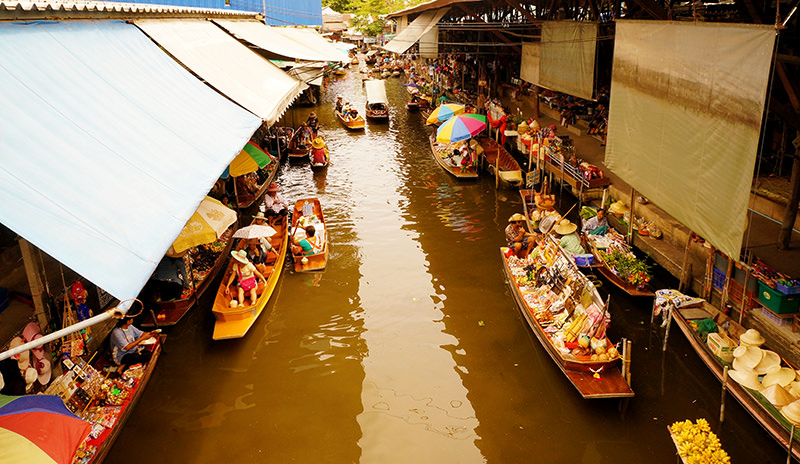 Damnoen Saduak Floating Market.
Damnoen Saduak Floating Market.
Amphawa Floating Market: located 90 km southwest of Bangkok. It is very authentic with many wooden houses neatly lined up along the canal, selling goods from souvenirs to snacks and sweets. You will see an amazing sight that a little temple swallowed by a giant tree located across the river. This market will be incredibly crowded after midday so it is wise to take a morning long-tail boat cruise.
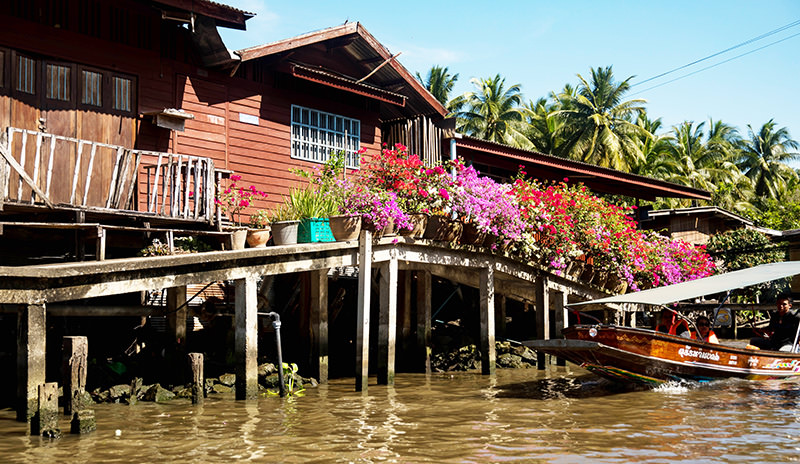 Wooden houses lining up along the canal.
Wooden houses lining up along the canal.
6. Stroll at Train Night Market Srinakarin, Bangkok
Voted as the coolest night market by young Thais, the Train Night Market Srinakarin is a commercial wonderland and an epitome of local people's lifestyle. It covers a vast area and the main crowds at the market are almost entirely Thai. People flock to Train Night Market Srinakarin not only for its excellent selection of antique and vintage goods sold at a very reasonable price but also for the delectable Thai street food on offer.
There are the largest second-hand goods exchange center of Bangkok, the largest collection exchange center of Bangkok, and many exclusive creative products. You will see lots of classic vintage furniture, vintage cars, and stereos as well as bars, coffee shops, and restaurants. You can taste all kinds of delicious and authentic snacks and shop for a variety of cheap apparel products. A goodly number of artists, musicians, and design talents gather here. The Train Night Market Srinakarin is a successful example of night markets in Thailand, which integrates retro fashion with local grass-roots culture.
Go if you want to experience the local nightlife of Thai people, and immerse yourself in the great atmosphere of this lovely train night market!
Location: Soi Srinagarindra 51, Khwaeng Nong Bon, Khet Prawet, Krung Thep Maha Nakhon 10250, Thailand
Business hours: 5:00 PM to 1:00 AM, Thursday to Sunday
7. Cook Traditional Lanna Food, Chiang Mai
The best souvenir from travel is definitely a skill which benefits you pretty much daily. A typical Thai cooking class in Chiang Mai is a likely option for you. Lanna food, also Northern Thai Food, boasts a rich culinary tradition and good flavor. It is a special set of food originated from the ancient Kingdom of Lanna which was centered in present-day Northern Thailand from the 13th to 18th centuries. As the last capital city of the Lanna Kingdom, Chiang Mai is the best city to find Lanna food at its best, and therefore the best place to learn the process of making it.
A food exploration
Start with a tour around the farm which the ingredients are sourced from. The instructor will introduce the names and uses of the ingredients, which include fresh vegetables, fruits, herbs used as seasonings, poultry and livestock. Then, you can select the dishes you would like to learn and then pick up the fresh ingredients from the farm accordingly. As the class is limited to 10 participants at the most, each one will be provided with necessary kitchenware, such as woks, spatulas and chopping boards.
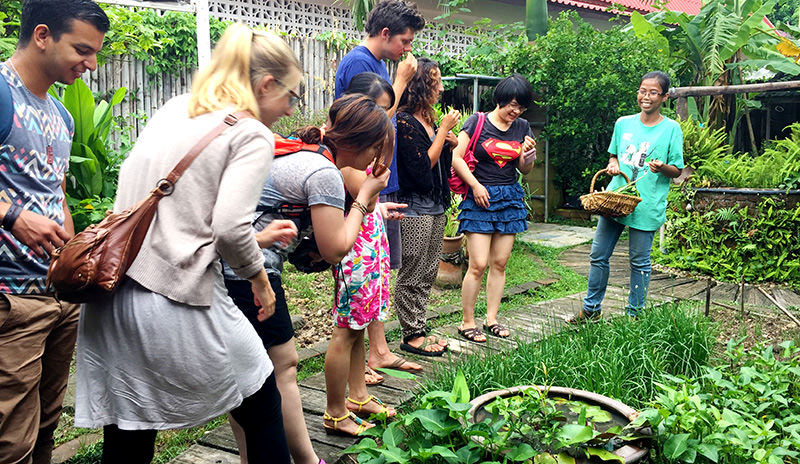 The instructor introducing the ingredients.
The instructor introducing the ingredients.
At the beginning of the class, the instructor will demonstrate the procedure of making the dishes step by step, including when to put ingredients into the wok, how to control heat and the exact amount of the seasonings. Then you repeat the procedure and make your own dishes. After finishing all the dishes, you, together with other participants, can sit around the table and share dishes with each other.
The appreciation of traditional Lanna food as a cultural treasure of Thailand is fading away, as more people prefer to reside in urban districts. By attending this wonderful cooking class, you will get a deep and thorough understanding of Lanna food, and also encourage locals to conserve this precious culinary heritage.
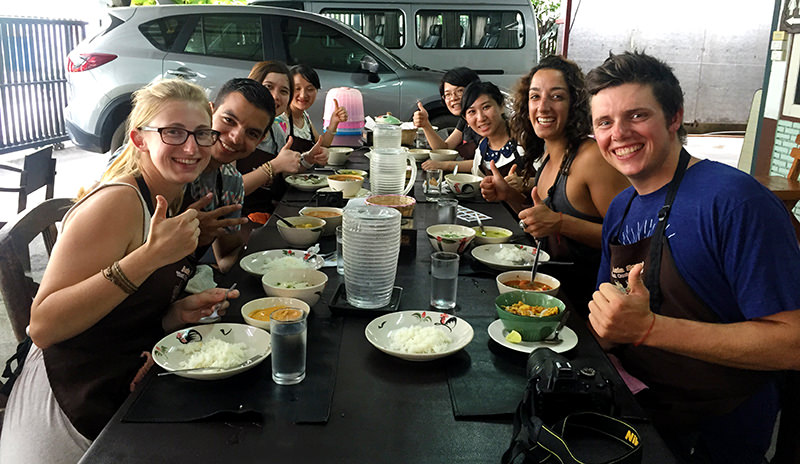 Participants sharing dishes with one another.
Participants sharing dishes with one another.
8. Enjoy an invigorating Thai massage
With a history of more than 4,000 years, Thai massage used to be one of the methods to strengthen the body and treat physical strain by the royal family in ancient Thailand. Meanwhile, it was the highest hospitality to royal guests by the ancient kings of Thailand. Incorporating yoga postures, Thai massage helps relieve stress, improve blood circulation and increase the flexibility of your body.
Thai massage begins from the feet towards the center of the body, emphasizing the stretch of back, waist and joint. It is considered as the most intense of all massages and it does not require the use of massage oil. Massagist uses two hands, two arms, two feet and even the whole weight of his/her body to push, pull, roll, step, and stretch the body of the experiencer. Compared with other forms of therapeutic massage, Thai massage tends to be more invigorating than relaxing.
You may feel a little pain because of the big movement if you are the first-time experiencer. Usually, the massagist will communicate with you about the intensity of the massage in advance, and remind you to completely relax the body.
Experiencing the Thai massage after the bath can quickly eliminate fatigue, restore physical strength as well as enhance the elasticity and vitality of the joint ligament, and promote the circulation of body fluids.
Notes:
1. Females should avoid Thai massage during menstrual periods because it may affect menstrual volume.
2. Children over 5 years old can try essential oil or foot massage as Thai massage is too intense for developing children.
3. The initial experience of Thai massage should not be too long (about one hour is recommended).
4. You need to change loose-fitting clothes before experiencing Thai massage.
5. Thai massage strictly avoids touching sensitive parts of the guests' body.
I hope this article will give you some inspiration to help get you started planning your next big adventure. Lao Tzu said, "The journey of a thousand miles begins with a single step." Therefore, don't hesitate to send the enquiry to us if you are thinking about visiting Thailand (and many other destinations in the world). Exclusively private tailored tours are available. Our travel specialists are at your service






